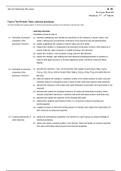Alevel Chemistry Revision IC 09
Revision Material
Duration: 2nd – 8th March
Topic 9 The Periodic Table: chemical periodicity
This topic illustrates the regular patterns in chemical and physical properties of the elements in the Periodic Table.
Learning outcomes
Candidates should be able to:
9.1 Periodicity of physical (a) describe qualitatively (and indicate the periodicity in) the variations in atomic radius, ionic
properties of the radius, melting point and electrical conductivity of the elements (see the Data Booklet)
elements in Period 3 (b) explain qualitatively the variation in atomic radius and ionic radius
(c) interpret the variation in melting point and electrical conductivity in terms of the presence of
simple molecular, giant molecular or metallic bonding in the elements
(d) explain the variation in first ionisation energy (see the Data Booklet)
(e) explain the strength, high melting point and electrical insulating properties of ceramics in
terms of their giant structure; to include magnesium oxide, aluminium oxide and silicon
dioxide
9.2 Periodicity of chemical (a) describe the reactions, if any, of the elements with oxygen (to give Na2O, MgO, Al2O3,
properties of the P4O10, SO2, SO3), chlorine (to give NaCl, MgCl2, Al2Cl6, SiCl4, PCl5) and water (Na and
elements in Period 3 Mg only)
(b) state and explain the variation in oxidation number of the oxides (sodium to sulfur only) and
chlorides (sodium to phosphorus only) in terms of their outer shell (valence shell) electrons
(c) describe the reactions of the oxides with water (treatment of peroxides and superoxides is not
required)
(d) describe and explain the acid/base behaviour of oxides and hydroxides including, where
relevant, amphoteric behaviour in reactions with acids and bases (sodium hydroxide only)
(e) describe and explain the reactions of the chlorides with water
(f) interpret the variations and trends in 9.2(b), (c), (d) and (e) in terms of bonding and
electronegativity
(g) suggest the types of chemical bonding present in chlorides and oxides from observations of
their chemical and physical properties
9.3 Chemical periodicity of (a) predict the characteristic properties of an element in a given group by using knowledge of
other elements chemical periodicity
(b) deduce the nature, possible position in the Periodic Table and identity of unknown elements
from given information about physical and chemical properties
, 9.1 Periodicity of physical properties of the elements in Period 3
(a) Chemical periodicity
Group 1 2 3 4 5 6 7 0
Element sodium magnesium Aluminum silicon phosphorous sulphur chlorine argon
character metal metalloid Non-metal
structure Giant metallic lattice macromolecular Simple molecular covalent
bonding Metallic bond between cations and Covalent bonds Intra = covalent
delocalized electrons between atoms Inter = weak VdWs
(b) Qualitatively Variation
- Atomic radius
From Na to Cl, the number of proton increase
The shielding effect is similar, the nuclear
attraction gets stronger. So the sizes get
smaller.
Ar is a noble gas, so it is a single atomic
molecule. Therefore the covalent radius is
unmeasured.
From Na+ to Si4+, the ionic sizes decrease as
- Ionic radius
less electrons and repulsion between the
electrons on outsells.
From P3- to Cl-, the ionic sizes also decrease
due to same reason, but all of them are larger
than (Na+, Mg2+, Al3+). The is because they are
more shielded.
- Melting point
The relative charge of cation increase (Na+,Mg2+,Al3+)
The size of metal cations decreases
The number of free electrons from Na to Al
The metallic bond gets stronger
Giant covalent lattice most energy need to overcome
Strong covalent bonds between Si atoms
S8 > P4 > Cl2 > Ar (P,S weak intermolecular)
(S8 stronger intermolecular forces)
The number of electrons in molecules
decreases in this order
VdWs forces gets weaker




